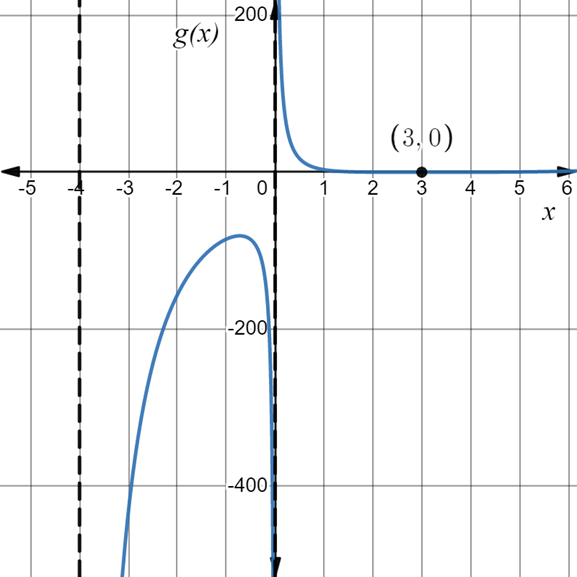
To find: The vertical asymptotes and intercepts of the given rational function.
The vertical asymptotes are equal to
Given information:
Consider the given function.
Calculation:
To find the vertical asymptotes, set the denominator equal to zero and solve for
So, the vertical asymptotes are
Now, find the intercepts of the given function.
For the
For the
Therefore, the
Now, using the sign chart and make a table of values to the draw the graph of the function.
First find the boundary points of the function
To set numerator and the denominator equal to zero. These are the values that make the quotient zero or undefined and solve for
And
So, the boundary points of the function
Now, locate these zeros on the number line (or sign chart) and dividing the number line into intervals and check the function

Now, make a table for the function
Now, draw the graph with help of above table:

Hence, the vertical asymptotes are
Chapter 2 Solutions
EBK PRECALCULUS:GRAPHICAL,...-NASTA ED.
- Find and classify the critical points of z = (x² – 8x) (y² – 6y). Local maximums: Local minimums: Saddle points: - For each classification, enter a list of ordered pairs (x, y) where the max/min/saddle occurs. Enter DNE if there are no points for a classification.arrow_forwardSuppose that f(x, y, z) = (x − 2)² + (y – 2)² + (z − 2)² with 0 < x, y, z and x+y+z≤ 10. 1. The critical point of f(x, y, z) is at (a, b, c). Then a = b = C = 2. Absolute minimum of f(x, y, z) is and the absolute maximum isarrow_forwardThe spread of an infectious disease is often modeled using the following autonomous differential equation: dI - - BI(N − I) − MI, dt where I is the number of infected people, N is the total size of the population being modeled, ẞ is a constant determining the rate of transmission, and μ is the rate at which people recover from infection. Close a) (5 points) Suppose ẞ = 0.01, N = 1000, and µ = 2. Find all equilibria. b) (5 points) For the equilbria in part a), determine whether each is stable or unstable. c) (3 points) Suppose ƒ(I) = d. Draw a phase plot of f against I. (You can use Wolfram Alpha or Desmos to plot the function, or draw the dt function by hand.) Identify the equilibria as stable or unstable in the graph. d) (2 points) Explain the biological meaning of these equilibria being stable or unstable.arrow_forward
 Calculus: Early TranscendentalsCalculusISBN:9781285741550Author:James StewartPublisher:Cengage Learning
Calculus: Early TranscendentalsCalculusISBN:9781285741550Author:James StewartPublisher:Cengage Learning Thomas' Calculus (14th Edition)CalculusISBN:9780134438986Author:Joel R. Hass, Christopher E. Heil, Maurice D. WeirPublisher:PEARSON
Thomas' Calculus (14th Edition)CalculusISBN:9780134438986Author:Joel R. Hass, Christopher E. Heil, Maurice D. WeirPublisher:PEARSON Calculus: Early Transcendentals (3rd Edition)CalculusISBN:9780134763644Author:William L. Briggs, Lyle Cochran, Bernard Gillett, Eric SchulzPublisher:PEARSON
Calculus: Early Transcendentals (3rd Edition)CalculusISBN:9780134763644Author:William L. Briggs, Lyle Cochran, Bernard Gillett, Eric SchulzPublisher:PEARSON Calculus: Early TranscendentalsCalculusISBN:9781319050740Author:Jon Rogawski, Colin Adams, Robert FranzosaPublisher:W. H. Freeman
Calculus: Early TranscendentalsCalculusISBN:9781319050740Author:Jon Rogawski, Colin Adams, Robert FranzosaPublisher:W. H. Freeman
 Calculus: Early Transcendental FunctionsCalculusISBN:9781337552516Author:Ron Larson, Bruce H. EdwardsPublisher:Cengage Learning
Calculus: Early Transcendental FunctionsCalculusISBN:9781337552516Author:Ron Larson, Bruce H. EdwardsPublisher:Cengage Learning





